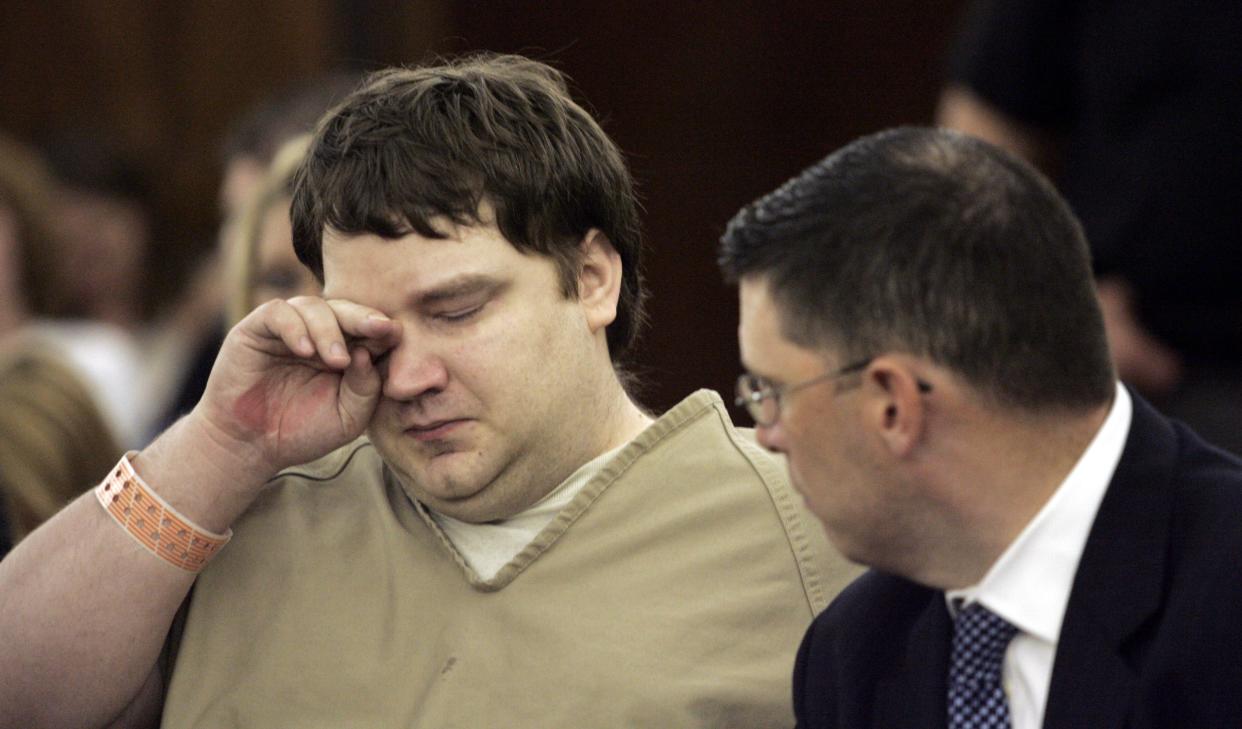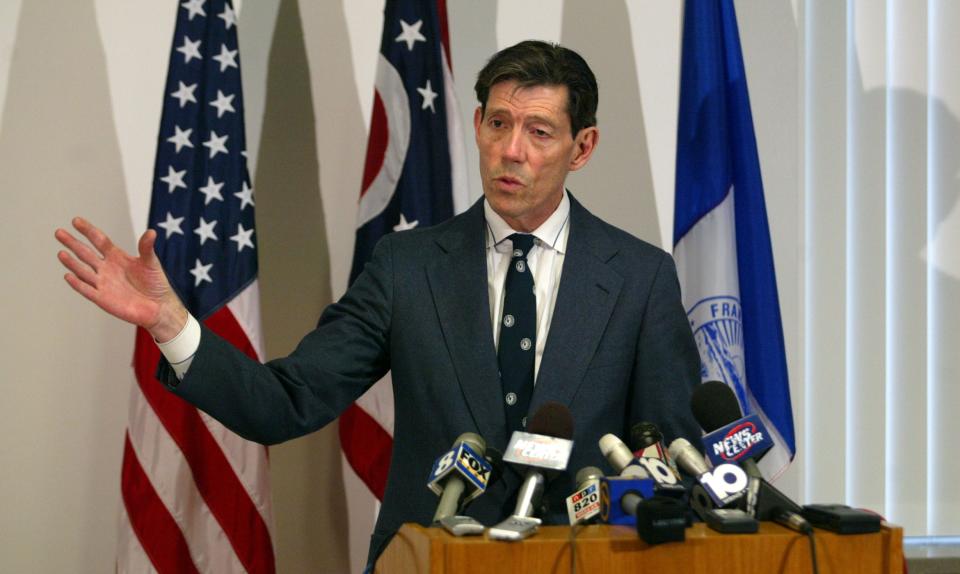Columbus sniper Charles McCoy had central Ohio driving in fear 20 years ago

- Oops!Something went wrong.Please try again later.
It was the Tuesday before Thanksgiving. Columbus was easing into the holiday.
Soon an up-until-then streak of random violence would capture the attention of the world.
At about 10 a.m. on Nov. 25, 2003, a 62-year-old Washington Court House woman named Gail Knisley was riding in a car driven by her friend on Interstate 270 on the South Side, near the I-71 interchange, when a bullet crashed through the door and struck her.
"I haven't heard anything out of her for a couple of minutes," the driver, Knisley's best friend of five decades, Mary Cox, then 63, of Grove City, pleaded on the 911 call. "Oh, please help me. Oh, Gail, honey, please, oh please."
Knisley was dead. A bullet hole the size of a quarter was noticeable on the driver's side door of Cox's 1993 Pontiac Grand Am, having narrowly missed Cox.
"They were driving to do Christmas shopping," had missed their exit while chatting and were planning on turning around, former longtime Franklin County prosecutor Ron O'Brien recalled in a recent interview. "All of sudden Ms. Knisley had slumped over."
Thus was launched one of the largest and longest manhunts in central Ohio law-enforcement history, lasting almost four months, and ending in the arrest in Las Vegas of Charles A. McCoy Jr., a 28-year-old mentally ill man.
McCoy was returned to Columbus 20 years ago this past week.
Despite having spent time in mental hospitals, McCoy had no problems legally buying firearms because he hadn't been "adjudicated" mentally ill, O'Brien said. He lived with his parents in a South Side house near the interstate, just west of Obetz.
Knisley killing helps police connect shootings
The Knisley killing was a wakeup call to police on what McCoy had been up to in southern Franklin County for months, but which slipped under the radar with police failing to connect the dots: A number of vehicles had been hit by gunfire in the area, but the reports were taken by different law-enforcement agencies. Five were investigated by the sheriff's office, two by Columbus police and one by the State Highway Patrol. They had all, except one, occurred since Oct. 11, 2003. But the first one stretched back to May.
No one had been seriously injured before the fatal shot, police said.
After Knisley's death, the shootings would sporadically continue until the arrest, with 24 incidents eventually linked to McCoy. He typically would show up on a freeway overpass that included no on or off ramps, squeeze off a round at a passing vehicle, and quickly slip away before police could respond.
Columbus drivers avoid the interstate in fear
In effect, everybody using a major Columbus highway was a potential target, making a commute to work or weekend shopping excursion an unnerving experience. As the shootings dragged on, Franklin County was driving in fear.
Many began detouring around the South Side or central Ohio altogether. The shots typically happened around the weekends, so "people on Thursday would start talking about staying off of 270 over the weekend because of the fear that he might reappear and shoot from an overpass, which was his habit," O'Brien said.

Adding to the drama, the incidents were occurring just as the "D.C. sniper attacks" trials were wrapping up against John Allen Muhammad, 41, and Lee Boyd Malvo, 17, convicted of randomly gunning down and killing 10 people around the nation's capital, while critically injuring three others.
The nation's eyes descend on Columbus
The national news media descended on Columbus. The Dispatch newsroom was routinely fielding calls from news organizations around the country and world, wanting interviews and the latest updates.
"I received interview requests from CNN, NBC, MSNBC and even did a radio gig with Mitch Albom in Michigan," said Bruce Cadwallader, a former Dispatch reporter who is now a spokesman for Franklin County Children Services. "NBC sent a satellite truck to my home one morning at 6 a.m. so I could do a hit with Lester Holt – they had received video of detectives re-enacting the shooting on I-270 by shining a laser through the bullet hole to try to determine the shooter’s locations."
Authorities tried to calm the jittery public.
"I'm not using the word 'sniper'," Chief Deputy Steve Martin of the Franklin County Sheriff's Office said after issuing a statewide alert to identify similar shootings.
But regardless of the term used by police, people feared a sniper, albeit one who was using a less-accurate handgun — a 9 mm Beretta semiautomatic — from close range, rather than a scoped rifle from a great distance. And he wasn't trying to conceal himself: sometimes motorists would see him standing there on a bridge as the shots hit their cars and trucks.
He struck Hamilton Central Elementary School in Hamilton Township in the middle of the night two weeks before Knisley's killing, an incident eventually linked to the same gun. Minor glass cuts were sustained by the driver of a tractor-trailer rig traveling along the south outerbelt near U.S. 23 around 11 p.m. on Oct. 19.
The Dispatch reported that officers even had to recontact one of the complainants and ask for the bullet retrieved from her vehicle, which she kept after the responding investigator told her he was going to chuck it in the trash.
FBI, others aid in investigation
But with the tragic and shocking Knisley killing, the investigation would move into overdrive. The sniper now had the community's full attention.
Police were quietly installing shot-spotting sound equipment on overpasses, hoping to respond more quickly, O'Brien said. Investigators set up a tip line, and ultimately received around 6,000 tips that officials had to sort through, an investigation that in addition to Columbus police and the Franklin County Sheriff's Office involved a special task force with the FBI, ATF, State Highway Patrol, and BCI, he added.
ODOT even completely shut down I-270 on the South Side for two hours so that police could thoroughly search it for clues.
That didn't deter the sniper: Two weeks into the hunt, a bullet tore through the front wall of a house on Lisle Avenue in Obetz shortly after 11 p.m. on a Sunday. It matched the gun.
Then on March 11, 2004, a tipster telephoned the task force hot line. It was tip No. 5,444.
"On the surface, it appeared no more significant than the 5,443 tips before it," retired FBI special agent Harry Trombitas wrote in a 2013 op-ed in the former ThisWeek Newspapers. "The tipster said that investigators should take a look at Charles A. McCoy Jr.
"The tipster said McCoy recently turned over a firearm to his father, and there had been some discussion within the family that McCoy might be involved in the shooting death of 62-year-old Gail Knisley less than five months ago."
Charles McCoy flees for Las Vegas
As police interviewed McCoy's parents, he watched from a parked car down the street — before deciding to flee to Las Vegas, O'Brien said. Police left the house with a gun, and within hours a lab had determined it to be "the" gun.
McCoy was arrested on March 17, 2004, in a Vegas casino when someone recognized his face on the cover of USA TODAY and was flown back to Columbus on an FBI plane, O'Brien added.
O'Brien pursued the death penalty before a grand jury, which indicted McCoy on 24 counts, including aggravated murder, related to 12 of the shootings. But as the court ordered mental evaluations that pointed to obvious schizophrenia, O'Brien said he probably wouldn't pursue an execution if he had it to do over.
It was clear that McCoy was mentally ill, and had a long history of issues, said Mark Collins, one of McCoy's defense attorneys. McCoy pleaded not guilty by reason of insanity, Collins said.
"There was no doubt that he had a mental disease," Collins told The Dispatch this week. "There was no doubt there were reasons what was going on with his life."
Although McCoy knew enough to flee, he used his real identification and credit card on his trip to and stay in Las Vegas, Collins said.
The jury was hung, after having deliberated 29 hours over five days. Four of the 12 jurors believed McCoy was insane when they delivered their verdict on May 8, 2005.
As a second trial loomed, McCoy accepted a plea deal to manslaughter in August 2005, and got 27 years in prison. Now 48, McCoy receives injections of a drug for schizophrenia, and has drastically improved, but Gov. John Kasich rejected a proposed clemency deal, Collins said.
The "real tragedy" was that a local gun dealer sold him "multiple guns, multiple times," because they weren't required to check on his mental health record, Collins said.
"Had they run him at all, they would have found that, yeah, he's been committed," Collins said. "He had a long history of being committed at that point in time.'
McCoy is expected to be released in March of 2031.
wbush@gannett.com
@ReporterBush
This article originally appeared on The Columbus Dispatch: Columbus sniper McCoy had central Ohio driving in fear 20 years ago

